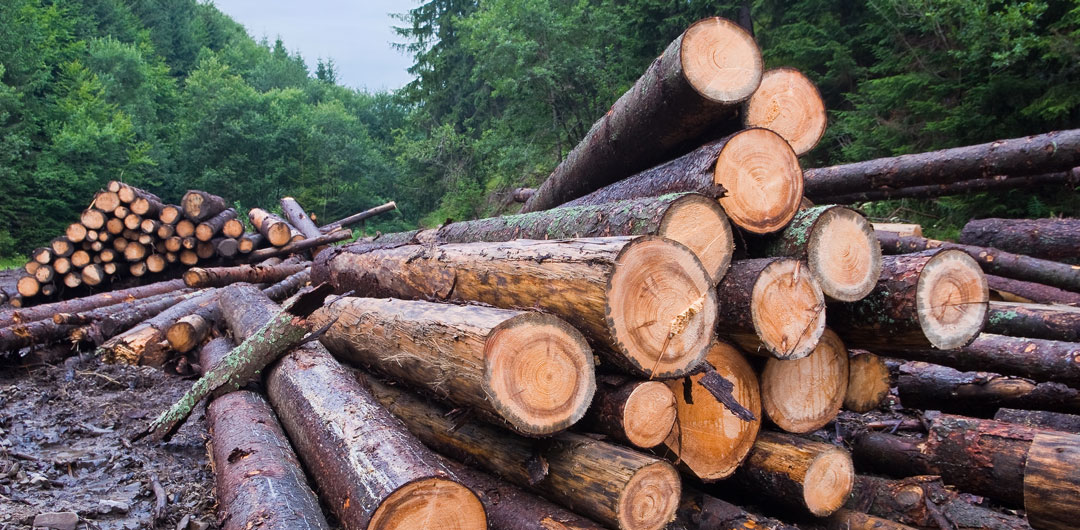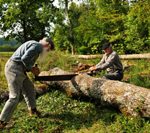“The Comstock Lode was the tomb of the forests of Tahoe.”
So reported Virginia City’s Territorial Enterprise in the 1890s, and truer words were never spoken.
Virginia City had silver ore in abundance, but it was buried deep under the bleak and barren flanks of Sun Mountain, now known as Mt. Davidson. The countryside surrounding the city lies in the rain shadow of the Sierra and Carson ranges to the west; average annual precipitation is only 12-14 inches, much of it as snowfall, and as a consequence there are no trees for miles around.
Yet to get at the precious silver ore under the city, the mines required hundreds of millions of board feet to shore up the shifting, crumbling ground in which silver ore was found. And it couldn’t be just any wood, either.
Mine frameworks had to be built of long-fibered wood that had enormous load capacity; at the lower levels of the mines, wood that began as foot-thick timbers compressed to two or three inches over a period of years. The wood also had to be flexible and give slowly under pressure, so that the timber would bow and emit an ominous creaking before failing, giving miners time to evacuate. Oak and other hardwoods were unsuitable, despite those woods’ reputation for strength and durability. They are short-fibered woods, and hence shatter abruptly and without warning. Miners avoided them.
Soft pine and fir were perfect for mining applications, and they grew in abundance within fifty miles of Virginia City’s voracious mines. The virgin forests surrounding Lake Tahoe were sacrificed to silver fever.
LUMBERING PRACTICES
Cutting Practices and Methods
Even before the discovery of silver on the Comstock Lode, the timber of the Sierra Nevadas was being pressed into service by emigrants flooding into California and gold miners stampeding to the gold fields. Lumber was needed for building houses, gold sluices, bridges, tunnels. Logging began.
With discovery of silver in Nevada in 1860 and the beginning of the transcontinental railroad in 1862, the demand for lumber escalated dramatically. During that era, the forests seemed unlimited and self-renewing, clear-cutting seemed the logical method, and great swathes of forest fell to the woodcutter’s ax. The hillsides surrounding Lake Tahoe were essentially mowed like fields of 200-foot-high grass.
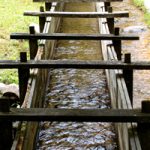 Flumes, Sluices and Other Modes of Transportation
Flumes, Sluices and Other Modes of Transportation
At first timber was cut in Alpine County, California, south of Lake Tahoe, and floated down the Carson River to Carson City, Nevada. The supply of suitable timber in that area was rapidly exhausted, and timbering moved to the area around Lake Tahoe itself.
Flumes (elevated wooden channels) were were seen at Tahoe as early as 1854. They were charged with water from smaller lakes nearer the summit; logs were fed into the flumes and gates at the top (called sluice gates) were opened, discharging water down the flumes and propelling cut timber to the lake.
The first flumes were U-shaped, four feet wide at bottom, five feet wide at top, and about thirty-two inches deep. The earliest design had the channel going straight from the top to the bottom of the slope; logs sliding toward the lake built up tremendous speed, trailing fire and smoke as they went. On occasion dare-devil loggers would ride a log to the bottom, leaping far out into the lake just as the log reached the water.
In 1867, James W Haines invented the V-flume. The cross-section was a V-shape, four feet on a side, and was a vast improvement over the older U-shape in that there were far fewer log jams and for the most part these were self-correcting. Blocked water backed up and floated the stuck timber free. The first Haines v-flume ran from Alpine County California to Empire City, Nevada, a total distance of over thirty-two miles.
Located just east of Carson City on the Carson River, Empire City was home to a number of sawmills and stamping mills for the Virginia City mines, all run by water wheels. Because of its position as a transit point for timber and ore (and also because of the frequent flooding) it came to be called the “Seaport of Nevada”.
Lumbering became Nevada’s second-largest industry, and multiple logging companies sprang up all around Lake Tahoe. As time went on, flumes were built on both sides of the Carson range, some down the western slope terminating in Lake Tahoe, others on the eastern slope terminating at the Carson River. By 1879, the Surveyor General for Nevada described ten major flumes in operation, totaling 80 miles long.
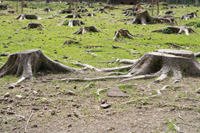 Environmental Impact
Environmental Impact
A hundred and fifty years ago, little thought was given to conservation practices. A few forward-looking lumbermen foresaw the need for replanting, but other than that, the environmental impact of clear-cutting was never considered.
The complete denuding of the Tahoe Basin had an impact far beyond just the destruction of the then-existing trees. The forest was originally widely spaced, primarily pine trees with high crowns and few branches near the ground. There were fir trees, but they did not predominate. After the clear-cutting, only the smaller fir trees remained, and those largely re-seeded the forest. This created an unhealthy balance of firs to pine, leading to a number of unsolved issues.
First, fir trees can be a greater fire hazard than pine. They are not as well adapted to Tahoe’s periodic drought conditions; branches and whole trees die off more frequently, leaving fire-prone dead wood. They also have branches near the ground, which can foster spread of a ground fire into the forest canopy.
Second, the new fir trees are all the same age, having sprouted immediately following the clear-cutting. This means that the fir forest will in general age and die at the same time, instead of renewing itself in perpetuity with overlapping generations.
Finally, fir trees are shade tolerant and grow closer together than pine trees, leading to an overcrowded forest that is too dense for the land to support. Pine trees do not grow well in that environment, further compounding the problem.
In recent years, forestry practices have changed in ways that may help mitigate some of the issues. Controlled burns, rather than total fire suppression, help thin out the firs and allow the pine forest to recover.
TYPES OF TIMBER
Lake Tahoe has an elevation of 6,225 feet. The Sierra Nevada Mountain range to the west of the lake increases gradually from about 9,000 feet to 14,000 feet south of the lake. The Carson Mountain range, a spur of the Sierras to the east of the lake, ranges in elevation from 9,600 to 10,900 feet.
Different types of timber grow in a different elevation range, though there is a certain amount of overlap. Ponderosa pine and incense-cedar predominate at the lowest levels of the Tahoe basin. Jeffrey pine, lodgepole pine and sugar pine inhabit the next level, and red and white fir are just above that, although white fir can be found at most elevations. At the highest level, above 9,000 feet, is the Western white pine (not widely distributed around Lake Tahoe, as elevations are not high enough.)
Incense-Cedar
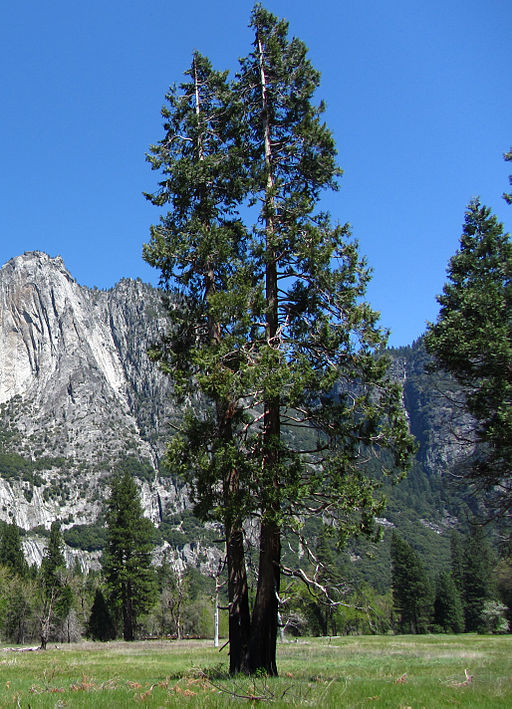 Incense-Cedar
Incense-Cedar
Incense-cedar grew over the widest elevation range, from sea level to a maximum of about 7,500 ft above sea level, and was found at the lowest levels of the Tahoe basin. It is a large tree, up to 180 feet tall and nine feet in diameter.
The wood is soft and often used where it will come in contact with the ground, as the heartwood is resistant to decay. It is also able to withstand great variation in temperature without warping.
The scent (and even taste) of this cedar is familiar to schoolchildren; the ubiquitous “Number 2 pencil” is made of it, as the wood cuts cleanly and doesn’t produce splinters. It also ranks high in the romantic-scents class; this is the wood used for antique bridal-chests.
IMAGE: By Victor R. Ruiz from Arinaga, Canary Islands, Spain (Fall) [CC BY-SA 2.0 (http://creativecommons.org/licenses/by-sa/2.0)], via Wikimedia Commons
Pine
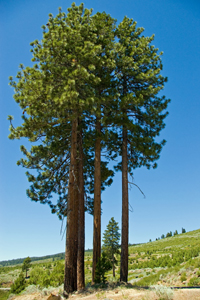 Ponderosa (Western Yellow Pine)
Ponderosa (Western Yellow Pine)
Although perhaps the best known of the Sierra pine varieties, the Ponderosa is actually less prevalent than the Jeffrey pine, which it closely resembles. It grows at a lower elevation, about 4000 to 8000 feet, and reaches 125 to 140 feet tall, with a three-to-four-foot diameter, sometimes up to eight feet.
Ponderosa and Jeffrey pine lumber was (and still is today) viewed as interchangeable with each other and was considered the best wood for general purposes. Both species produced a good percentage of clear lumber, were stronger than sugar pine, and were reasonably abundant in the Tahoe basin at the time. Since Ponderosa grew at lower elevations than the Jeffrey pine, however, it was more accessible for harvest.
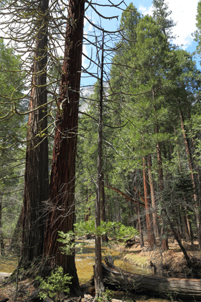 Jeffrey Pine (also called Yellow Pine)
Jeffrey Pine (also called Yellow Pine)
Jeffrey Pine is the most common tree species in the Tahoe basin. It is similar in appearance to the Ponderosa pine, and for a time both were considered the same species.
The Jeffrey pine is drought-tolerant, and adapts well to cold weather because it requires a shorter growing season than the Ponderosa. It typically grows four to six feet in diameter, and 170 to 200 feet in height, somewhat larger than the Ponderosa. It also grows in a wider elevation range than its smaller sibling, from nearly sea level to 9,500 feet.
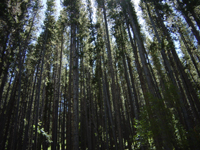 Lodgepole Pine
Lodgepole Pine
In the climate belt dominated by the Jeffrey pine, lodgepole pine is the second most common species. A tall, straight tree, it is much smaller than the other local pines, averaging only 24 inches in diameter and 70 feet high.
This species tolerates frost well, and is adapted not only to survive forest fires but to recover quickly. It is one of the first trees to re-sprout after a fire. It is, however, susceptible to drought.
As suggested by its name, it was frequently used by Native Americans in building their lodges, but less desirable than other species to the Comstock miners due to its smaller size.
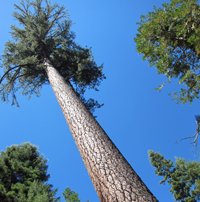 Sugar Pine
Sugar Pine
Sugar pine grew at the mid pine-forest elevations, at about 4000-8000 feet. The individual trees are the tallest of the pines, from 160-180 feet tall, with a four-to-seven-foot diameter. It produces the largest of the pine cones, a foot or more in length.
During the Comstock era, the sugar pine was viewed as a valuable wood because it was easily worked and fairly clear. Along with the rest of the pine species, it was largely clear-cut during that time period and is only now recovering.
Fir
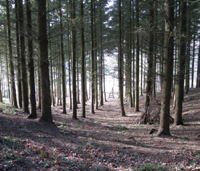 Douglas Fir (Douglas Spruce)
Douglas Fir (Douglas Spruce)
Douglas fir was one of the most prized woods, strong and considered the most valuable of the species. It grew at roughly 2500-6000 feet, but was quite prevalent at that level. Individual trees ranged from 100-150 feet high, with a diameter of three to six feet.
This species no longer grows around Lake Tahoe, but as recently as 2006 a single specimen of the Pacific Douglas fir still grew at the lake. With that exception, the species has been harvested to near extinction in Northern Nevada.
IMAGE: Robin Stott [CC BY-SA 2.0 (http://creativecommons.org/licenses/by-sa/2.0)], via Wikimedia Commons
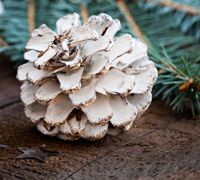 White Fir (Silver Fir)
White Fir (Silver Fir)
White (or silver) fir is the second most common tree in the Tahoe area, right after the Jeffrey Pine. Moreover, it grows at the 4000-7500 foot elevation, near that of Lake Tahoe, so during the Comstock era it was readily accessible.
However, white fir is an indifferent wood. The trees aren’t large, compared to the pine; it grows only 80 to 195 feet tall, with a trunk diameter of five to six feet. In addition, the wood is too soft, is full of knots and flaws, takes too long to dry, and warps badly. In the 1800s it was mostly used for firewood along with scrap wood and pine tops, and today is viewed as a bit of a “weed” tree.
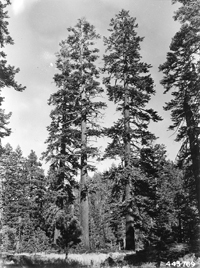 Red Fir
Red Fir
Red fir grew over entire Lake Tahoe area but it was neither abundant nor accessible. Nonetheless, the larger specimens were taken down along with most of the other old-growth forests around the lake and put to use in the mines.
It grew at a slightly higher elevation than the other firs, and was somewhat larger than the Douglas fir (130–200 feet high, with diameters up to five feet).
IMAGE: By USDA Forest Service Photo, 1946 (USDA Forest Service Photo, 1946) [Public domain], via Wikimedia Commons
FURTHER READING AND OTHER REFERENCES
BOOKS
Wilson,Dick. Sawdust Trails in the Truckee Basin: A History of Lumbering Operations, 1856-1936. Nevada County Historical, 1992.
ARTICLES IN A PRINT JOURNAL
Straka, Thomas J. “Timber for the Comstock.” FOREST HISTORY TODAY | Spring/Fall (2007): 4-15. http://www.foresthistory.org/Publications/FHT/FHTSpringFall2007/FHT_2007_Comstock.pdf
WEBSITES
Trees of Lake Tahoe – The Pines, Ted C. MacRae, http://beetlesinthebush.wordpress.com/2009/03/28/trees-of-lake-tahoe-the-pines/
Trees in Transition, USDA Forest Service, https://www.fs.usda.gov/detail/ltbmu/learning/?cid=stelprdb5109573
(Posted August 2017)
